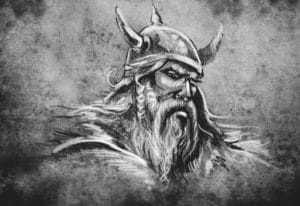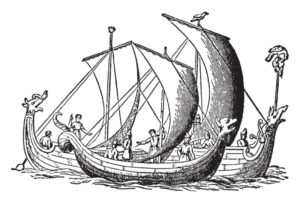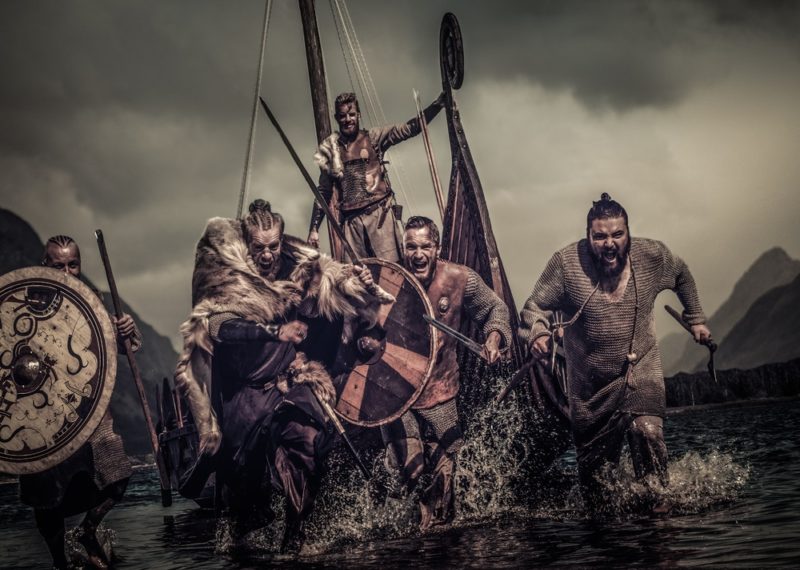Ivar the Boneless has gained an iconic reputation in multiple regards. Born Ivar Ragnarsson, he was unlike previous Viking raiders. Perhaps his differences ultimately led him to become one of the most feared and infamous Viking warlords in history.
Ragnarsson was not a typical Norse warrior. He had larger intentions than the typical looting and stealing. It was his ultimate goal to achieve domination in English and Irish territories. What drove him will be discussed in further detail below.
Separating myth from reality can be a challenge with a figure as historic as Ivar. Some of the information provided requires a grain of salt for this exact reason. Nevertheless, the warlord was a very colorful character who has captivated the interests of historians around the globe.

Was Ivar the Boneless Crippled?
Intriguingly, scholars have suggested that he was disabled from birth. He had weak bones and possibly had a hereditary skeletal condition. Yet, Ivar the Boneless had a brilliant strategic mind and developed intimidating leadership skills. He was the mastermind behind massive conquests and battles.
Legends say that throughout his life, Ivan the Boneless had to be assisted frequently. His body was severely limited. He had a strong physical stature and was very tall though according to some sources. Historians believe he could have had Osteogenesis imperfecta, more commonly known as Brittle Bone Disease, but this can never be confirmed.
According to Johns Hopkins Medicine, Brittle Bone Disease is “an inherited (genetic) bone disorder that is present at birth…A child born with OI may have soft bones that break (fracture) easily, bones that are not formed normally, and other problems.”
Was Ivar Respected and Feared?
Ivar did not allow his unidentified disease stop him from planning and executing large invasions into the United Kingdom and Ireland. This earned Ragnarsson very high status among fellow Vikings. His character was of a very evil nature, while also being highly intelligent.
Ivar was heartless when it came to competitors and enemies, but was dedicated to his family. Most accounts recognize that he loved his father and brothers. His devotion to his bloodline does not lessen his ruthlessness.
Why Was Ivar Called the Boneless?
Ivar’s descriptive nickname could have alluded to his bone condition (also referred to as a snake metaphor), yet still remains a mystery. Another reasoning historians have suggested is of sexual nature. There are no records of Ragnarsson fathering any children. This would indicate he had no “love lust.”
Ivar’s Early Background
Ivar was born in an area that would now be modern Denmark. Since he came from a respected Viking family of Danish origin, his life was saved as an infant. In his era, a majority of sick babies were purposely executed as they were deemed worthless and a burden.
Ivar was the son of a powerful Viking and Danish king, Ragnar Lodbrok (also referred to Ragnar Lothbrok). In accordance with legend, the king received attention for his feud with the iconic historical figure, Charlemagne. Lodbrok was eventually assassinated by King Ælla in a disgusting way. The king threw Ragnar Lodbrok into a pile of venomous snakes.
Great Heathen Army
The Birth of the Army
After Ragnar’s death, his sons sought revenge. Some sources suggest Ivar was deeply affected by his father’s death. He became enraged and wanted to wreak havoc on the man who killed his father. A group of Ragnar’s sons including Ivar thus established the Great Heathen Army. The army became an unmatched large Viking force.
Despite his health challenges, it was Ivar the Boneless who eventually led the Great Heathen Army in their attacks on Anglo Saxon kingdoms. Ivar sought conquest of England as a whole. Many of Ivar’s peers including his brothers recognized his genius as a tactician and strategist.
With his brothers, Halfdan and Hubba by his side, Ivar and the Great Heathen Army overthrew York and surrounding cities in Anglo Saxon England. According to Historic U.K., over two thousand five hundred Viking soldiers were a part of the army. There is a historical debate on the real motivations behind the Viking campaign.
While some historians claim Ivar and his army sought to conquer England as an act of vengeance, others argue that it was purely a motive of personal gain and influence. History suggests that Ælla overtook areas that were once conquered by Ragnar Lothbrok. As a result, Ivar and his brothers wanted to regain what they believed was their birthright. Both factors certainly could have played a role.
Anglo Saxon Chronicle
Ivar led his brothers and the Viking army successfully into East Anglia, England. East Anglia, in modern-day England, contains Norfolk, Cambridgeshire, and Suffolk. The army raided and was able to conquer the kingdom of Northumbria as a result. Once they established their presence in the area and found King Ælla, they ensured he received a brutal death. Ivar never forgot that his father, Ragnar Lodbrok, was thrown into a snake pit.
What is the Blood Eagle Method of Execution?
To reciprocate the favor, legend has it that Ivar ordered a blood eagle execution. According to the Smithsonian Magazine, the execution method refers to when Vikings separated “the victim’s ribs from their spine, pulling their bones and skin outward to form a set of “wings,” and removing their lungs from their chest cavity.” The concept of blood stained wings had a ceremonious and cultural meaning to Vikings. Blood eagle executions historically have never been confirmed nor denied.
Norse Warriors
After they captured Northumbria, its king, Osbert, was also faced with a savage and brutal death. The Vikings then became the rulers of areas in England for a period of time. Ivar placed a puppet ruler in place to oversee Northumbia named King Egbert. In Ivar the Boneless’s view, things were just beginning. There was so much more to conquer. Ivar was the true definition of a Norse warrior.
According to Norse sources, the Great Heathen Army then made its way to invade Nottingham, which was located in Mercia. Mercia leadership was prepared when Ivar apparently came to the kingdom, forcing the army to return to conquered York. King Alfred had besieged Nottingham when Ivar the Boneless arrived to protect its surroundings.
Eventually, they did come back to the kingdom of Mercia. It was then that Ivar was able to kill King Edmund, the king of East Anglia.
The Vikings decided to try to conquer Wessex after the king’s death, though there is evidence that Ivar was not a part of these attempts. The Wessex attack did not go well. This was a Viking saga Ivar was probably glad he was not a part of.
Ivar’s Relationship with Olaf the White
Throughout Ivar the Boneless’s career, he occasionally collaborated with Olaf the White, an Irish-born Viking. He is often referred to as the Viking king of Dublin. During the 850’s, Olaf and Ivar Ragnarsson participated in multiple battles together in Ireland.
Ivar cut ties with Olaf for a period of time, but then rekindled their partnership in the 870’s.
While other Vikings went into Wessex, Ivar and Olaf decided to conquer Dumbarton rock and its surrounding city, in what is now present-day Scotland. After they destroyed Dumbarton, they crossed the Irish sea and took over Dublin.
Dumbarton rock became a place of new beginnings for Ivar. The events that took place at the battle site earned him immense power in Ireland.
Ivar the Boneless and Olaf the White became very powerful and successful in their partnership. Legend has it that they ultimately became Irish rulers.
The Demise of Ivar the Boneless
How Did Ivar Die?
According to Wikipedia, the Norse warrior died of a sudden and horrible disease in Ireland. Ivar’s year of death is approximately 873. This sudden hideous disease could have been related to his health challenges and proposed disability. Considering his limitations, Ivar the Boneless lived a long life. He was approximately born in the mid 800’s, roughly 830.
Where is Ivar the Boneless Buried?
Despite records indicating that he died in Ireland, others suggest he died in England. There are rumors that Ivar was buried in a mass grave in Repton. The gravesite was first discovered by Thomas Walker in the 1700’s. Long forgotten, it was rediscovered by Professor Martin Biddle in the 1970’s.
When Biddle found the mass grave, a nine-foot-tall skeleton was in the middle of a bunch of other warrior skeletons. A sword and Thor hammer were placed with the massive body. The large size of the remains found aligns with legends that say Ivar the Boneless was a physically gigantic individual. Though his stature could have been easily exaggerated.
The remains discovered at Repton have never been confirmed or denied to be Ivar the Boneless’s. As of the present day, his precise burial location is not known.
Ivar’s Legacy
In his own time, Ragnarsson became a very important Viking warlord that was known for his cruelness and ruthlessness. Ivar remains one of the most famous and mysterious figures of all time. His life has grown into speculation and myth.
Was Ivar the Boneless Real?
The real Ivar and what he achieved is not quite clear because Viking history is often tied to legend. What historians do believe is that Ivar Ragnarsson was indeed a real man who did see success in conquering Anglo Saxon kingdoms.
The real Ivar could have had similarities to the legends surrounding him. Legends always tend to exaggerate and historians are cautious when discussing the actual historical figure behind Ivar the Boneless.
Both Norse and British records paint a picture of the man called Ivar Ragnarsson. Both accounts could not be any more different. Viking sagas lift him up as a savior, while English papers describe him as the face of evil. The Harley MS (Harley Collection) has been a prime British documentation set that describes Ragnarsson.
These resources have led historians to confidently believe in the reality of Ivar the Boneless and his acts. It is the specific details of his career and what his acts fully entailed that are up to debate.
Was Ivar the Boneless Ímar?
Historically, both figures seem to be the exact same person based on achievements and records. Ímar established the Uí Ímair dynasty near the Irish Sea territory, which aligns perfectly with the Danish leader’s controversial accomplishments.
The influence Ivar the Boneless had on Ireland is pretty well certain, considering the success he had with Olaf the White. The sagas related to Ímar seem to very much refer to Ragnarsson.
Hollywood Ivar
The historical Ivar has become subjected to modern pop culture frenzy. Still to this day, there is something exciting and intriguing about Viking sagas and history. Ivar the Boneless has become a popular character in Viking books, television programs, and motion pictures. The entertainment industry has taken great creative license in how they portray Ivar.
Contrary to the fictional Ivar created by Hollywood, Ragnarsson did not murder his brother, Björn Ironside (Bjorn Ironside), or his brother, Sigurd. According to Norse legend, he was close with his family. The conqueror had a great relationship with his father, Ragnar, and wanted to avenge his cruel death.
Ivar teamed up with his brothers to attempt to achieve his greatest dream, which was holding immense power in the areas his father once controlled. Together as a family, they developed the impressive and intimidating army that allowed them to execute Ragnar’s murder and take control of York.
Ivar the Boneless is a popular character on The History Channel’s Vikings television show. There is very little similarity between the real Ivar and who he is portrayed to be on the show. On the show, he murders family members among other inconsistencies.
Where History Meets Legend
From his attacks on East Anglia and England to his influence in Ireland, the Norwegian king described in Norse legend was every bit worthy of his reputation. In the eyes of the Viking community, he was indeed a god-like figure.
Was Ragnarsson Really a God?
No, he was a normal and infamous human being. The legendary Ivar became a mythical, superhero-like figure in Viking history. His gifts and skills led him to become celebrated in the eyes of his peers, but around the world, he was a hated individual who did far more bad than good.
Ivar the Boneless was a terrible and miserable man who resorted to violence and conquest. Tactically, he was beyond wise so he could properly earn the title “evil genius.”
What Are Viking Sagas?
A Viking saga is simply another term to describe Norse legend. These sagas are the stories that have been passed on for generations about Ivar the Boneless, Leaf Erickson, and every major Viking figure.
Much of the content shared here is based on traditional sagas. These sagas have been written in Old Norse. According to Encyclopedia Britannica, “Old Norse language, classical North Germanic language used from roughly 1150 to 1350. It is the literary language of the Icelandic sagas, skaldic poems, and Eddas.”



